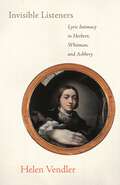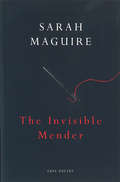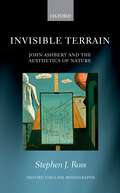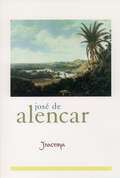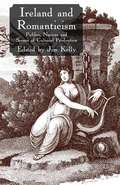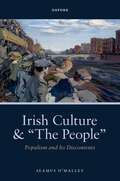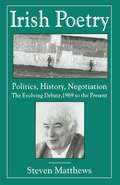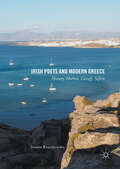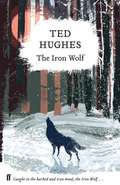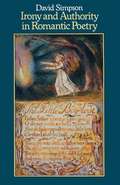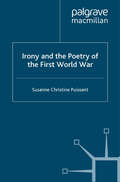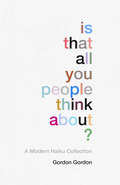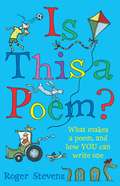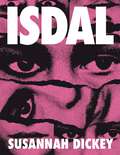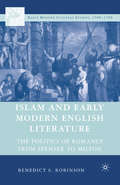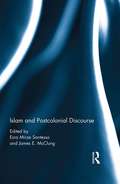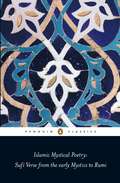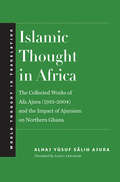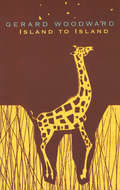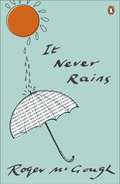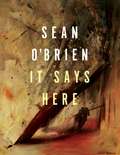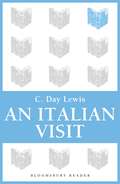- Table View
- List View
Invisible Listeners: Lyric Intimacy in Herbert, Whitman, and Ashbery
by Helen VendlerWhen a poet addresses a living person--whether friend or enemy, lover or sister--we recognize the expression of intimacy. But what impels poets to leap across time and space to speak to invisible listeners, seeking an ideal intimacy--George Herbert with God, Walt Whitman with a reader in the future, John Ashbery with the Renaissance painter Francesco Parmigianino? In Invisible Listeners, Helen Vendler argues that such poets must invent the language that will enact, on the page, an intimacy they lack in life. Through brilliantly insightful and gracefully written readings of these three great poets over three different centuries, Vendler maps out their relationships with their chosen listeners. For his part, Herbert revises the usual "vertical" address to God in favor of a "horizontal" one-addressing God as a friend. Whitman hovers in a sometimes erotic, sometimes quasi-religious language in conceiving the democratic camerado, who will, following Whitman's example, find his true self. And yet the camerado will be replaced, in Whitman's verse, by the ultimate invisible listener, Death. Ashbery, seeking a fellow artist who believes that art always distorts what it represents, finds he must travel to the remote past. In tones both tender and skeptical he addresses Parmigianino, whose extraordinary self-portrait in a convex mirror furnishes the poet with both a theory and a precedent for his own inventions. By creating the forms and speech of ideal intimacy, these poets set forth the possibility of a more complete and satisfactory human interchange--an ethics of relation that is uncoerced, understanding, and free.
The Invisible Mender
by Sarah MaguireLucid, complex, sensual and richly textured, the poems in The Invisible Mender are notable for the breadth of their subject matter and the precision of their detail. We travel on journeys through landscapes dense with historical and political meanings, from the post-industrial decline of frozen North America to the stymied fecundity of a London garden paralysed in a heatwave: each emotional and physical climate explored and illuminated by the writer's astonishing images and searching intelligence. This is the work of unusual power and frankness, unflinching in its steady examination of grief and love, as in the heartbreaking title poem about the poet's loss of her first mother. But here, and in the magnificent long poem 'The Hearing Cure' this explicit engagement with what is difficult also reveals the redemptive, healing force of language. Sarah Maguire's outstanding first collection of poems, Spilt Milk, was published to considerable critical acclaim and led to her being chosen as one of the New Generation Poets. The Invisible Mender, her eagerly awaited second volume, will confirm her reputation as one of the most exciting young poets in Britain.
Invisible Terrain: John Ashbery and the Aesthetics of Nature (Oxford English Monographs)
by Stephen J. RossIn his debut collection, Some Trees (1956), the American poet John Ashbery poses a question that resonates across his oeuvre and much of modern art: 'How could he explain to them his prayer / that nature, not art, might usurp the canvas?' When Ashbery asks this strange question, he joins a host of transatlantic avant-gardists—from the Dadaists to the 1960s neo-avant-gardists and beyond—who have dreamed of turning art into nature, of creating art that would be 'valid solely on its own terms, in the way nature itself is valid, in the way a landscape—not its picture—is aesthetically valid' (Clement Greenberg, 1939). Invisible Terrain reads Ashbery as a bold intermediary between avant-garde anti-mimeticism and the long western nature poetic tradition. In chronicling Ashbery's articulation of 'a completely new kind of realism' and his engagement with figures ranging from Wordsworth to Warhol, the book presents a broader case study of nature's dramatic transformation into a resolutely unnatural aesthetic resource in 20th-century art and literature. The story begins in the late 1940s with the Abstract Expressionist valorization of process, surface, and immediacy—summed up by Jackson Pollock's famous quip, 'I am Nature'—that so influenced the early New York School poets. It ends with 'Breezeway,' a poem about Hurricane Sandy. Along the way, the project documents Ashbery's strategies for literalizing the 'stream of consciousness' metaphor, his negotiation of pastoral and politics during the Vietnam War, and his investment in 'bad' nature poetry.
Invisible Terrain: John Ashbery and the Aesthetics of Nature (Oxford English Monographs)
by Stephen J. RossIn his debut collection, Some Trees (1956), the American poet John Ashbery poses a question that resonates across his oeuvre and much of modern art: 'How could he explain to them his prayer / that nature, not art, might usurp the canvas?' When Ashbery asks this strange question, he joins a host of transatlantic avant-gardists—from the Dadaists to the 1960s neo-avant-gardists and beyond—who have dreamed of turning art into nature, of creating art that would be 'valid solely on its own terms, in the way nature itself is valid, in the way a landscape—not its picture—is aesthetically valid' (Clement Greenberg, 1939). Invisible Terrain reads Ashbery as a bold intermediary between avant-garde anti-mimeticism and the long western nature poetic tradition. In chronicling Ashbery's articulation of 'a completely new kind of realism' and his engagement with figures ranging from Wordsworth to Warhol, the book presents a broader case study of nature's dramatic transformation into a resolutely unnatural aesthetic resource in 20th-century art and literature. The story begins in the late 1940s with the Abstract Expressionist valorization of process, surface, and immediacy—summed up by Jackson Pollock's famous quip, 'I am Nature'—that so influenced the early New York School poets. It ends with 'Breezeway,' a poem about Hurricane Sandy. Along the way, the project documents Ashbery's strategies for literalizing the 'stream of consciousness' metaphor, his negotiation of pastoral and politics during the Vietnam War, and his investment in 'bad' nature poetry.
Iracema (Library of Latin America)
by José de AlencarJose de Alencar's prose-poem Iracema, first published in 1865, is a classic of Brazilian literature--perhaps the most widely-known piece of fiction within Brazil, and the most widely-read of Alencar;s many works. Set in the sixteenth century, it is an extremely romantic portrayal of a doomed live between a Portuguese soldier and an Indian maiden. Iracema reflects the gingerly way that mid-nineteenth century Brazil dealt with race mixture and multicultural experience. Precisely because of its nineteenth-century romanticism, Iracema strongly contributed to a Brazilian sense of nationhood--contemporary Brazilian writers and literary critics still cite it as a foundation for their own work.
Ireland and Romanticism: Publics, Nations and Scenes of Cultural Production
by Jim KellyThis collection by leading scholars in the field provides a fascinating and ground-breaking introduction to current research in Irish Romantic studies. It proves the international scope and aesthetic appeal of Irish writing in this period, and shows the importance of Ireland to wider currents in Romanticism.
Irish Culture and “The People”: Populism and its Discontents
by Seamus O'MalleyThis book argues that populism has been a shaping force in Irish literary culture. Populist moments and movements have compelled authors to reject established forms and invent new ones. Sometimes, as in the middle period of W.B. Yeats's work, populism forces a writer into impossible stances, spurring ever greater rhetorical and poetic creativity. At other times, as in the critiques of Anna Parnell or Myles na gCopaleen, authors penetrate the rhetoric fog of populist discourse and expose the hollowness of its claims. Yet in both politics and culture, populism can be a generative force. Daniel O'Connell, and later the Land League, utilized populist discourse to advance Irish political freedom and expand rights. The most powerful works of Lady Gregory and Ernie O'Malley are their portraits of The People that borrows from the populist vocabulary. While we must be critical of populist discourse, we dismiss it at our loss. This study synthesizes existing scholarship on populism to explore how Irish texts have evoked "The People"—a crucial rhetorical move for populist discourse—and how some writers have critiqued, adopted, and adapted the languages of Irish populisms.
Irish Culture and The People: Populism and its Discontents
by Seamus O'MalleyThis book argues that populism has been a shaping force in Irish literary culture. Populist moments and movements have compelled authors to reject established forms and invent new ones. Sometimes, as in the middle period of W.B. Yeats's work, populism forces a writer into impossible stances, spurring ever greater rhetorical and poetic creativity. At other times, as in the critiques of Anna Parnell or Myles na gCopaleen, authors penetrate the rhetoric fog of populist discourse and expose the hollowness of its claims. Yet in both politics and culture, populism can be a generative force. Daniel O'Connell, and later the Land League, utilized populist discourse to advance Irish political freedom and expand rights. The most powerful works of Lady Gregory and Ernie O'Malley are their portraits of The People that borrows from the populist vocabulary. While we must be critical of populist discourse, we dismiss it at our loss. This study synthesizes existing scholarship on populism to explore how Irish texts have evoked "The People"—a crucial rhetorical move for populist discourse—and how some writers have critiqued, adopted, and adapted the languages of Irish populisms.
Irish Poetry: The Evolving Debate, 1969 to the Present
by S. MatthewsThe award of the 1995 Nobel Prize for Literature to Seamus Heaney recognized not only the aesthetic achievement of his work, but also its political urgency. Here Steven Matthews presents a genealogy of Irish poetry which centres upon Heaney's recent preoccupation with the relations between poetry, politics and history. Writing from the perspective of Irish critical responses to the poetry, he discusses a wide range of work from John Hewitt through Heaney himself to Paul Muldoon. All of these poets have been inspired directly or indirectly by the situation in the North of Ireland. Placing the poems in their historical context, the author also analyses how these poets have reacted to the influence of W.B. Yeats. This important book offers a new approach to Irish poetry, linking it for the first time to the crucial political and historical events which lie at its centre.
Irish Poets and Modern Greece: Heaney, Mahon, Cavafy, Seferis
by Joanna KruczkowskaThis book explores the perception of modern Greek landscape and poetry in the writings of Seamus Heaney and Derek Mahon. Delving into travel writing, ecocriticism, translation and allusion, it offers a fresh comparative link between Greek modernity and Irish poetry that counterbalances the preeminence of Greek antiquity in existing criticism. The first section, devoted to travel and landscape, examines Mahon’s modern perception of the Aegean, inspired by his travels to the Cyclades between 1974 and 1997, as well as Heaney’s philhellenic relationship with mainland Greece between 1995 and 2004. The second section offers a close analysis of their C. P. Cavafy translations, and compares George Seferis’ original texts with their creative rendition in the writings of the Irish poets. The book will appeal to readers of poetry as well as those interested in the interactions between Ireland and Greece, two countries at the extreme points of Europe, in times of crisis.
The Iron Wolf: Collected Animal Poems Vol 1
by Ted HughesThe Iron Wolf, the Iron WolfStands on the world with jagged fur.The rusty Moon rolls through the sky.The iron river cannot stir.The iron wind leaks out a cryAnimals of air, land and sea are brilliantly imagined in this perfect introduction for young readers to the work of Ted Hughes. Part of Hughes's Collected Animal Poems, The Iron Wolf is for the youngest readers, both to listen to and explore themselves. Chris Riddell's delightful line illustrations add to the journey of discovery.
Irony and the Poetry of the First World War
by S. PuissantHow does irony affect the evaluation and perception of the First World War both then and now? Irony and the Poetry of the First World War traces one of the major features of war poetry from the author's application as a means of disguise, criticism or psychological therapy to its perception and interpretation by the reader.
Is That all You People Think About?: a collection of modern haikus
by Gordon Gordon'A fine, if sometimes rude, collection of haikus inspired by modern life' Daily Telegraph‘I’m in here!’ yelled Mum.Hide and seek was spoilt again.We never found Dad.The word ‘Haiku’ invokes images of misty mountains, running streams and falling leaves. But where are the haiku that reflect the modern world we live in? The real world of overflowing baths, train delays and Pierce Brosnan?In this collection, you will find a haiku for every moment of modern life, all rendered in no more or less than 17 syllables.
Is This a Poem?: What makes a poem, and how YOU can write one
by Roger StevensDo you like poems? Are you sure you know what one is?!Join popular poet Roger Stevens for a trip through the different types of poetry: from advertising jingles to football chants, and from free verse to rap. Then, why not have a go at writing a poem of your own?
ISDAL: Shortlisted for the Forward Prize for Best First Collection
by Susannah DickeyShortlisted for the 2023 Forward Prize for Best First CollectionThe much-anticipated debut poetry collection from acclaimed novelist Susannah Dickey, on the subject of our cultural obsession with true crime.ISDAL is a timely interrogation of the true crime genre. In the first of its three parts, we follow the flirty co-presenters of a podcast about the mystery of 'Isdal Woman', whose burnt remains were discovered in Norway in 1970 and who has never been identified.At the centre of the book is an inquiry into our perennial obsession with female victims, sexiness, and death: ‘The death in question has already occurred’, the poet observes, ‘has occurred to someone sufficiently abstract as to allow us to romp gainfully, guilelessly, guiltlessly through a simulacrum of death’s corridors’.The free verse poems in the final section both explore and – perhaps inevitably – enact the ethical ambiguities of the genre. Witty, excoriating, formally ingenious, ISDAL marks the arrival of a thrilling talent in contemporary poetry.
Islam and Early Modern English Literature: The Politics of Romance from Spenser to Milton (Early Modern Cultural Studies 1500–1700)
by B. RobinsonThis book traces the process through which authors like Spenser, Shakespeare, and Milton adapted, rewrote, or resisted romance, mapping a world in which new cross-cultural contacts and religious conflicts demanded a rethinking of some of the most fundamental terms of early modern identity.
Islam and Postcolonial Discourse: Purity and Hybridity
by Esra Mirze Santesso James McClungLargely, though not exclusively, as a legacy of the 2001 attack on the World Trade Center, Islamic faith has become synonymous in many corners of the media and academia with violence, which many believe to be its primary mode of expression. The absence of a sophisticated recognition of the wide range of Islamic subjectivities within contemporary culture has created a void in which misinterpretations and hostilities thrive. Responding to the growing importance of religion, specifically Islam, as a cultural signifier in the formation of a postcolonial self, this multidisciplinary collection is organized around contested terms such as secularism, Islamopolitics, female identity, and Islamophobia. The overarching goal of the contributors is to facilitate a deeper understanding of the full range of experiences within Islam as well as the figure of the Muslim, thus enabling a new set of questions about religion’s role in shaping postcolonial identity.
Islam and Postcolonial Discourse: Purity and Hybridity
by Esra Mirze Santesso James McClungLargely, though not exclusively, as a legacy of the 2001 attack on the World Trade Center, Islamic faith has become synonymous in many corners of the media and academia with violence, which many believe to be its primary mode of expression. The absence of a sophisticated recognition of the wide range of Islamic subjectivities within contemporary culture has created a void in which misinterpretations and hostilities thrive. Responding to the growing importance of religion, specifically Islam, as a cultural signifier in the formation of a postcolonial self, this multidisciplinary collection is organized around contested terms such as secularism, Islamopolitics, female identity, and Islamophobia. The overarching goal of the contributors is to facilitate a deeper understanding of the full range of experiences within Islam as well as the figure of the Muslim, thus enabling a new set of questions about religion’s role in shaping postcolonial identity.
Islamic Mystical Poetry: Sufi Verse from the early Mystics to Rumi
by Mahmood JamalWritten from the ninth to the twentieth century, these poems represent the peak of Islamic Mystical writing, from Rabia Basri to Mian Mohammad Baksh. Reflecting both private devotional love and the attempt to attain union with God and become absorbed into the Divine, many poems in this edition are imbued with the symbols and metaphors that develop many of the central ideas of Sufism: the Lover, the Beloved, the Wine, and the Tavern; while others are more personal and echo the poet's battle to leave earthly love behind. These translations capture the passion of the original poetry and are accompanied by an introduction on Sufism and the common themes apparent in the works. This edition also includes suggested further reading.
Islamic Thought in Africa: The Collected Works of Afa Ajura (1910-2004) and the Impact of Ajuraism on Northern Ghana (World Thought in Translation)
by Alhaj Yusuf Ajura Zakyi IbrahimThe first book length-work on Afa Ajura and translation of his complete poems This is the first English translation of and commentary on the collected poems of Alhaj YŠ«suf á¹¢Ä?liḥ Ajura (1910–2004), a northern Ghanaian orthodox Islamic scholar, poet, and polemicist known as Afa Ajura, or “scholar from Ejura.” The poems, all handwritten in Arabic script, mainly in the Ghanaian language of Dagbani and also Arabic, explore the author’s socio†‘religious beliefs. In the accompanying introduction, the translator examines the diverse themes of the poems and how they challenge TijÄ?niyyah Sufi clerics and traditional practices such as idol worship.
Island To Island (Chatto Poetry Ser.)
by Gerard WoodwardIn Island to Island, his third collection of poetry for Chatto, Gerard Woodward ventures into more hostile, less familiar territory. An Arabian desert, the moon, thinly-populated archipelagos are all visited in what emerges as an investigation into the nature of social space. A giraffe trapper finds that a successful trap must closely resemble a giraffe's own home; the 'suburban glass' of starter-home conservatories glazes and crysallises the lives of newly-weds. With his characteristic exuberance and ability to stand the world on its head, Woodward combines tichly imagined poems about half-invented lands with poetry that transforms the ordinary into the fantastical, where baths become oceans and ceilings lunar landscapes. Nor is the body exempt from this exploration of borders and limits. In one poem, two 'gurning' contestants find that they've overstepped some boundary of humanness and in 'The Madness of Heracles', a long retelling of the myth of the twelve labours, human strength is put to the test in a poem which evolves into a rhapsody of love, loss, toil and redemption.
It Never Rains
by Roger McGoughIt Never Rains by Roger McGough - an expanded edition of comic verse and free line drawings, from the nation's favourite poetWhile up at MagdalenSpent the time dagdalen.Moved on to CaiusBecame the baius knaius.'Oxford Blues' is one of the many new poems in this expanded and revised edition of The State of Poetry, Roger McGough's book of short humorous verse which was published in 2005 as part of Penguin's 70s series celebrating its 70th anniversary. From a poem commissioned to commemorate Dylan Thomas in just 140 characters, which unfortunately comes to an end mid-word, to a pre-emptive erratum notice, these poems show McGough at his inventive, hilarious best - and there are also new line drawings by the author offered at no extra cost.'The patron saint of poetry' Carol Ann DuffyRoger McGough was a member of the group Scaffold in the 1960s when he contributed poems to the Penguin title The Mersey Sound, which has since sold over a million copies and is now available as a Penguin Classic. He has published many books of poems for children and adults, and both his Collected Poems (2004) and Selected Poems (2006) are also available in Penguin. He presents Poetry Please on Radio 4 and is President of the Poetry Society. He was honoured with the Freedom of the City of Liverpool in 2001 and with a CBE in 2005 for services to literature.
It Says Here
by Sean O'BrienIt Says Here is Sean O’Brien’s follow-up to his celebrated collection Europa, and has a vision as rich and wide-ranging as its predecessor. Set against shorter, ruthlessly focused pieces – vicious and scabrous political sketches and satires charting the growth of extremism and the disintegration of democracy – are meditations on the imaginative life, dream and remembrance, time and recurrence. There are elegies for friends and fellow poets; paranoiac, brooding pastorals; other poems lay bare the maddening trials of a historically literate mind as it attempts to navigate a world gone post-content, post-intellectual, and at times post-memory. At the centre of the book is the long poem Hammersmith, a shadowy, cinematic dream-vision of England during and since the Second World War. Here, O’Brien charts a psychogeographic journey through the English countryside and the haunted precincts of London, mapping a labyrinth of love, madness and lost history. The result is a stirring, illuminating document of a time of immense societal flux and upheaval by one of our finest poets and most insightful cultural commentators.'In both technical mastery and his belief in the seriousness of the poetic art, O’Brien is WH Auden’s true inheritor.' Irish Times
An Italian Visit
by C. Day LewisIn this work, first published in 1953, C. Day Lewis, former Professor of Poetry at Oxford, chooses a form that enables his various gifts to be displayed to advantage and to sustain rapt interest in a poem longer than convention now favours.It is a poem in seven parts: 'Dialogue at the Airport'; 'Flight to Italy'; 'A Letter from Rome'; 'Bus to Florence'; 'Florence: Works of Art'; 'Elegy Before Death: at Settignano'; 'The Homeward Prospect'. The whole resembles a suite in music; various metres are used, and each part is self-contained, though all are on the same subject - a journey to and in Italy. The poet has used his first impressions of the country to illustrate certain deeper themes indicated by the epigraph: '... an Italian visit is a voyage of discovery, not only of scenes and cities, but also of the latent faculties of the traveller's heart and mind.'If anybody has had the slightest doubt about Mr. Day Lewis's ability to practice what he professes so eloquently and vigorously in his lectures, An Italian Visit should be convincing proof that its author is a poet in the full and splendid exercise of his powers.' Eric Gillett in the National Review.
